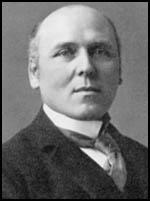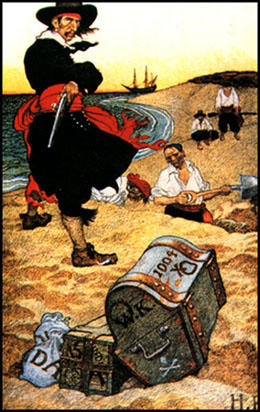Howard Pyle

Howard Pyle was born in Wilmington, Delaware on 5th March, 1853. He studied at the Arts Student League in New York City and the Pennsylvania Academy.
Pyle contributed to a number of magazines including Harper's Monthly and Scribner's Magazine. He also illustrated books such as The Merry Adventures of Robin Hood (1883) and The Book of Pirates (1902).
Peter Crimmins has claimed that during this period Pyle invented the iconic look of the mythical pirate. "Pyle blended the look of a 16th century sailor with a Spanish Gypsy, with distinct accouterments: a headscarf, a gold earring, and a long sash around the waist. But a real sailor would never wear those things."
Pyle has been described as the "father of American illustration" because of the enormous influence his work had on other artists. Pyle taught at the Arts Student League, the Drexel Institute, and his own art schools at Chadd's Ford and Wilmington. His students included Maxfield Parrish, Newell Convers Wyeth, Frank Schoonover, Olive Rush, Ethel Franklin Betts and Philip R. Goodwin. mith.
Howard Pyle died in Florence of a kidney infection on 9th November, 1911.

Primary Sources
(1) Peter Crimmins, Pirates of Pizazz (16th November, 2011)
The Delaware Art Museum is celebrating its 100th anniversary with pirates.
The Wilmington museum was founded with the paintings and illustrations of artist and illustrator Howard Pyle, immediately following his death.
Pyle is perhaps most famous for his 1883 illustrations for "The Merry Adventures of Robin Hood." He also invented the iconic look of the mythical pirate.
Pyle blended the look of a 16th century sailor with a Spanish Gypsy, with distinct accouterments: a headscarf, a gold earring, and a long sash around the waist.
But a real sailor would never wear those things.
"Could you imagine climbing a rigging with a sash this long?" said historian and illustrator David Rickman. "A headscarf--why would you wear a headscarf when sailors then and today wear stocking caps? There's no real reason for this."
The headscarf, earring, and sash may not work at sea, but they work very well on the page where the pirate's job is not to sail a ship but instead look distinct, exotic, and dangerous. That was Pyle's genius.
"He created something out of mixing something from history and made something very seductive," said Rickman. "So seductive that no pirate ever wore anything differently. When one person can change the world's view of something--that's remarkable. All the world only recognizes pirates because of Howard Pyle."
The pirate paintings by Pyle hanging in the Delaware Art Museum show lean and grizzled men with hard features and bloodthirsty eyes--a far cry from the dapper rogues in "Pirates of Penzance," the 1879 Gilbert and Sullivan operetta.
"Back in the day, pirates were entrepreneurs, no different than I am today," said Pat Croce, a fitness mogul, former owner of the Philadelphia 76ers basketball team, and founder of St. Augustine Pirate and Treasure Museum in Florida.
Those crooks and murderers have been so thoroughly romanticized that even Disney has made heroes of them. While Pyle created the look of the pirate, the sound of the pirate was invented by actor Robert Newton as Long John Silver in Disney's "Treasure Island" from 1950.
